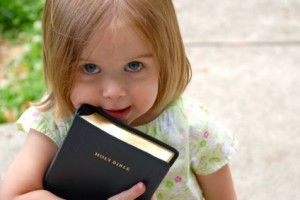We probably all know the words to the children’s Bible class song, “The B-I-B-L-E, yes that’s the book for me”. How can we help teach our children that the Bible really is for them? After all, it is a huge book, much bigger than any other book they would be expected to read or know! How do we make it a book that isn’t so overwhelming to our little ones?
First of all, we keep the Bible in view in all of our Bible classes. Even in the cradle roll class, there are ways to do this. First, let each baby have their own little copy of the New Testament. There are songs that the teacher can sing to the children encouraging them to “Pat the Bible” or to “love their Bible”.
Another idea for cradle roll and preschool age is to have one larger Bible that the teacher uses with pictures that are hidden inside the pages. When teaching a very young class that God made the world, I would say something like, “Let’s open God’s book to see what He made”. Then I proceed to open the Bible to pages with hidden pictures such as a tree, sun, animal, or baby. My pictures were those copied from a pattern book or taken from a magazine and laminated for durability. Children could hold the pictures of things found in God’s book. It gives a visual representation that a young child can understand of stories contained in the Bible. We want children to always understand that we aren’t just telling a great fictional story, but these stories are true and found in this book. You could use this concept when teaching other stories as well. For Noah, you could include pictures of an ark, animals, rainbow, and people on the ark. For Jonah, you could have a ship, Jonah, big fish. The same idea could work with most any story.
Encourage children of all ages to have their own copy of the Bible and bring it to class. I don’t mind if it is a real Bible or a children’s version, it helps a child develop the habit that will stay with them.
As children develop their reading skills, (1st & 2nd grade), we should teach them to find verses in their own Bible. When giving a memory verse, I give a handout with a verse that has some words already there and some blanks. The children have to fill in the verse by looking up a passage. Here’s an example of the progression in teaching a child to find the verse. Let’s use John 3:16 as an example:
- “We’re looking for John. Is that in the Old or New Testament?” (“New”, they say. Remember you are or have already taught books of the Bible)! If they don’t know, take this time to go through your books of the Bible and then ask again).
- “Now, open your Bible. Anywhere it lands is fine”. (Let’s say it opened to Proverbs).
- “Is Proverbs in the Old or New Testament?” (“Old”, they say). “Oh, we’re looking for the New Testament so start flipping pages to the left until you find a book that is in the New Testament”.
- Now let’s say they get to the New Testament and landed in Mark. “Great! Mark is in the New Testament. Is it before or after John?” “Before” they say, so I tell them to flip a few more pages over.
- Once they get to John, point out the chapter numbers which are usually a little bigger. We’re looking for a “3”.
- Now they are at John 3. Point out verse numbers and with their finger, scroll down and hold their place at “16”.
- Yay!! They’re at John 3:16. You can read the verse aloud with them and complete blanks on the worksheet that has the memory verse!
Obviously all children will be landing a different places in their Bibles, so I am walking around the class giving individual instruction to anyone who is having difficulty.
You can take this gigantic book and teach them to find a single verse with this process of narrowing it down to the right verse. By the time we used this method over a few short months, even my newly reading 1st grade students could find verses!
As children get a little older and more familiar with their Bibles, encourage them to mark important passages and make neat notes. Encourage them to use maps and references books, or a concordance in Bible study. A great way to do this is during your pre-class session using one on one instruction or worksheets.
Sword drills are a fun way to teach children who know how to find things, but may need practice with speed. A sword drill is simply making a game out of looking up verses quickly. They can play as individuals or as a team to find a verse or information within a verse. It can be done orally or by filling in answers on a worksheet. For example, “Find the name the king mentioned in a 1 Kings 2:23” or “Find Proverbs 3:5” or “What is the 6th word in Acts 2:38?” You get the idea. Give children a purpose for finding things in their Bibles. It can be fun and really improve on speed and familiarity with their Bibles.
One quick note about doing sword drills. Remember to never embarrass a child who is a struggling reader, who doesn’t attend regularly, or is visiting when playing games that require previous knowledge. The last thing we want to do is to discourage a child, so be sensitive to your students and play accordingly!
Teaching children to be familiar with God’s word is one of the most important concepts that we can give to children. Let’s enthusiastically help them to know that the B-I-B-L-E really is the book for us all!
